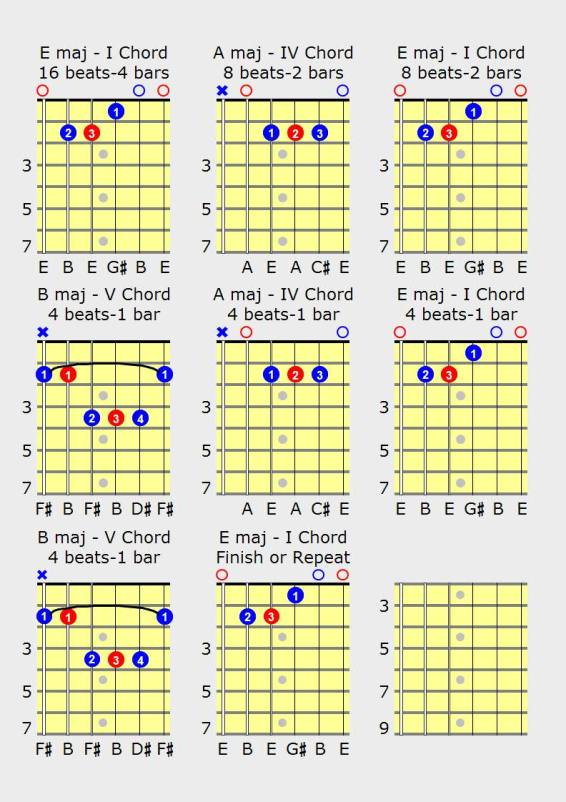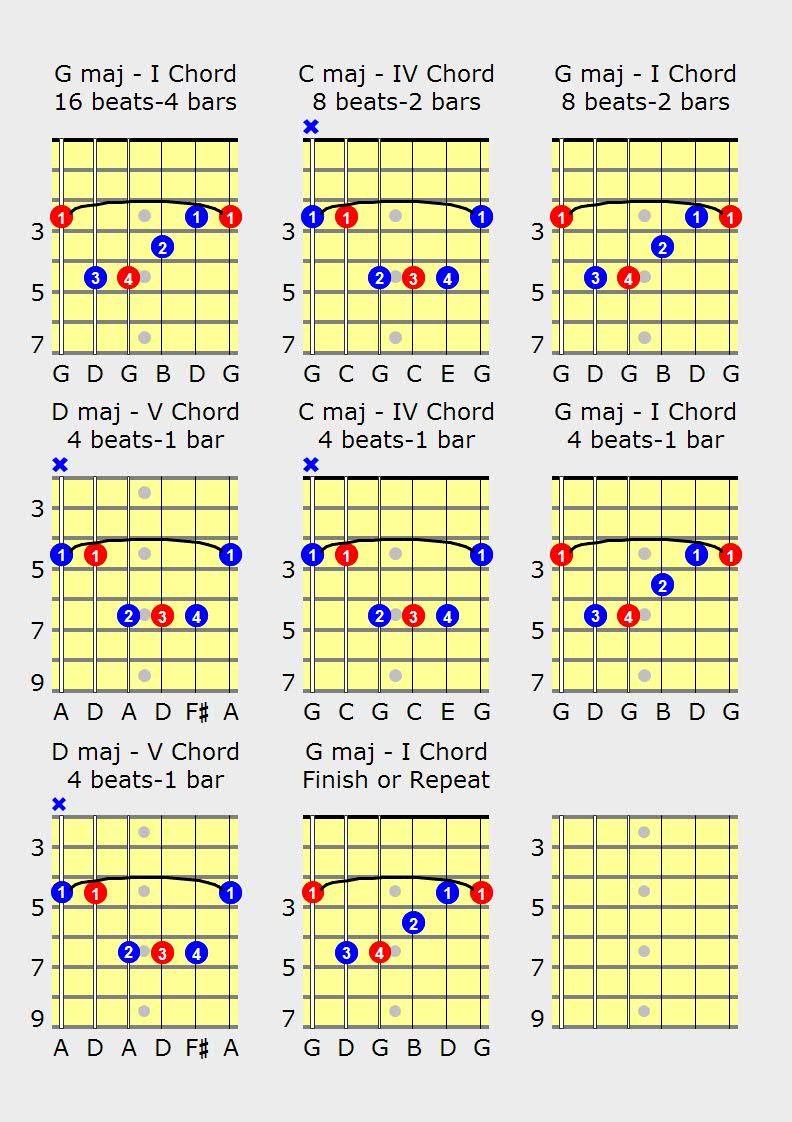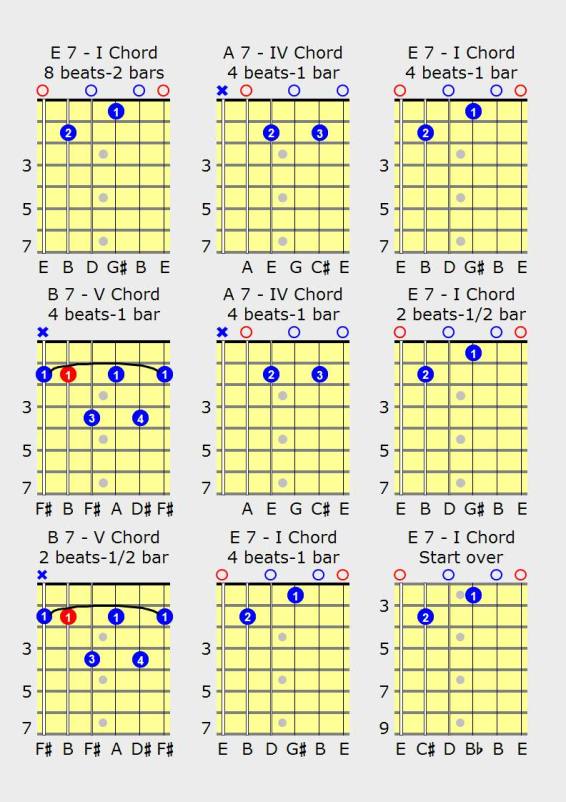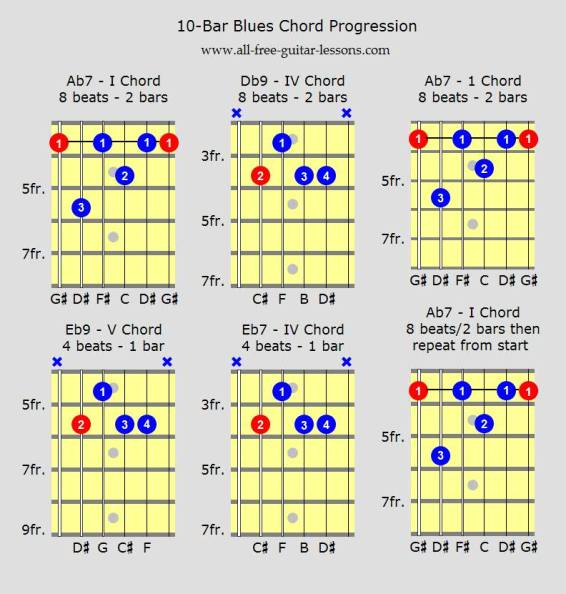Blues Guitar Chords
These blues guitar chords and their progressions will hopefully have you playing the blues in no time at all. They're all for beginners and intermediate players as they contain both easy to play open chords, as well as the more difficult barred chords. If you want to play blues guitar to any real level though, you will need to be able to play barre chords, so keep practicing if you can't play them already.
If you want to jump straight down to the blues guitar chord progressions just click on any of the following links. Alternatively, if you want to learn a little of the theory behind blues guitar in general as well as the theory of blues guitar chords and their progressions then please read on. There is also descriptive text before each chord progression that may be missed if you do decide to jump straight down.
Website owners and Bloggers
You're free to copy and use my charts on your website or blog if you choose. All I ask in return is that you leave the URL of this site intact on those charts that have it and show your appreciation to all my time and hard work by linking back here, thank you.
All these chords can of course be played on both electric and acoustic guitars. Just remember, barre chords are harder to play on an acoustic guitar, so if you're a beginner you'd better get the electric out!
And don't miss the instructional videos after the charts!
Electric Blues Guitar
For beginners
E Major 12-Bar Blues Chord Progression
Acoustic Blues Guitar
For beginners & intermediate players
A#/Bb Acoustic 12-Bar Blues Chord Progression
Why not take a look at the blues guitar licks video and/or the videos at blues guitar instruction.
The Art of Blues Guitar
Without doubt, blues guitar is probably the most covered form of guitar playing in the Western world, not only in its own right, but also in other musical styles too. The influence of 'the blues' is constantly heard in many forms of music such as; pop, rock, soul, country and even jazz. Blues guitar and the scales associated with it, namely the major and minor pentatonic scales and blues guitar scales respectively, are a common and constant influence on these other popular musical genres. Well how could we expect anything less, as all these other musical styles all developed out of 'the blues'!
To be able to play 'the blues' well requires a thorough knowledge of the pentatonic and blues guitar scales as mentioned above and relative blues guitar chords as shown in the chord charts further down this page. Get these scales and chords under your belt and learn them well enough so you can play them blind folded!
Once you've got to grips with the blues scales and chords put on some slow blues music and try to play along. One of the most difficult things to get to grips with for beginners is to be able to play in time. This requires awareness and lots of practice. Start by playing slowly and try to feel the music. It's very important not to run before you can walk as they say. You can create a lot of feeling with just a few notes providing you are playing with meaning and playing in time, whether you're playing alone or with others.
Playing Arpeggios
'Arpeggios' is the musical term given to playing the notes within a chord individually as opposed to strumming the chord. By picking the notes out of the blues guitar chords as well as strumming the chords creates extra musical colour and more interest to the listener. When this is combined with picking out the notes of the blues guitar scales even more blues colour and atmosphere is created. By adding the Mixolydian mode to the mix spices it up further to create more of a jazz-blues vibe.
As already said, playing in time is the most important aspect of playing any instrument well, not how many notes you can hit. Play as slowly as you have to play in order to play in time and to get it right!
Theory of Blues Guitar Chords
Now, as previously stated on the blues guitar lessons page, blues is traditionally based on a I, IV, V chord progression consisting of twelve bars. The I, IV, V is pretty much in stone for pure blues and the blues guitar chords and their progressions on this page are all structured in that way. However, the number of bars in any blues chord progression can change. It doesn't have to remain at 12 bars. It can be 8 bars or 16 bars for example. This can give it a different feel as well as a longer or shorter span before it resolves back to the I chord. Dominant seventh chords can also be played at certain points in the chord progression or if you like the whole tune can be made up completely of seventh chords. It really is up to you, so remember, if it sounds good, play it! Experiment.
These blues guitar chords and their progressions can be played in any key by moving the whole progression up or down the fret board. This will move the root note and the tonal centre, thereby changing the key. The first two chord charts below show this perfectly. The second chord progression is a repeat of the first blues chord progression in as much as it uses the same chord shapes throughout. The only difference is these chords are played in different positions.
As you will see, the first blues chord progression on the first chart starts at the first fret with the open E major chord, while the second progression on the second chart starts at the third fret with the barred G major chord which comes from the open E major chord shape. When you move an open chord shape up the neck it has to be barred to re-create the position of the nut and to complete the chord or it would just sound strange and be incorrect.
As already mentioned, the first blues chord progression starts on E major. This is the I chord of the blues progression. Again, it is called the I (one) chord because it is built on the first note of a major scale and not because it is played first. The second chord of this blues progression is the IV chord (four chord) because it's built from the 4th note of the major scale and therefore known as the IV chord and is A major in this particular case. The V chord (five chord) is called so because it is built on the fifth note of the major scale and is B major in this case.
Note: If you know your major scales, you will know that the first note of the E major scale is obviously E, the fourth note of the E major scale is A, and the fifth note of the E major scale is B. This I, IV, V chord progression is the standard basic chord progression for blues guitar as already mentioned, but worth repeating for beginners.
Start memorising where the root notes of each chord are. They're highlighted in red and include the open strings. They're always in the same place within the chord and the root note is what gives that chord it's name, tonal centre and over all sound. This will be indispensible to you later on for improvising and relating to what substitute chords to play and where to play them, as well as what scales to play over what chords, whether you're playing blues, or other styles of music.
The first two blues guitar chords progressions contain only major triad chords. Triads are chords that contain only three notes. These chords are very common to most popular forms of music and styles. It is the I, IV, V progression that gives the chord progression that 'blues feel'. The different ways they can be played, as well as varying tempos also changes the mood of the music you are playing.
If you're a beginner, to keep it simple, remember that one beat is basically one strum, and four strums or beats make up one bar in 4/4 time which is what this will be. The following blues guitar progression consists of 12 bars or 48 beats. The first chord, E major, will be strummed 16 times, the second chord, A major, 8 times and so on.
Don't worry about all of this if you don't understand it. The main thing is just to practice as much as you can to get a feel for it. You'll pick up the theory as you go.
Practice!
E Major 12-Bar Blues Chord Progression
Blues Guitar Chords Chart #1

This next blues chord progression is exactly the same as the first, but it has all been moved up 3 frets and therefore requires the use of more barre chords.
G Major 12-Bar Blues Chord Progression
Blues Guitar Chords Chart #2

Now you may think to yourself 'well that's great but it drags on a bit'. Well all you have to do is shorten the number of bars to the piece of music so that there are less beats or strumming actions over all. There still remains four beats to each bar, but there are less bars of music to the entire song. The blues chord progression below not only shows this, but it also uses dominant seventh chords to give this blues guitar chord progression a slightly different sound.
You can also take this one step further by changing the number of beats at any given time so you just make it up as you go and to what sounds good to you at the time.
These blues flavoured guitar chords contain the b7 (flat 7th) note of the major scale giving it that 'open bluesy flavour'.
Wonderful!
8-Bar Blues Chord Progression
E - Dominant 7s
Blues Guitar Chords Chart #3

This video demonstrates different tempos and rhythms for playing not only blues guitar chords, but also other chords for other styles of music.
The Licks in the above video can be seen at blues guitar licks
Now, moving on slightly, the following blues guitar chord chart is basically a simplified version of the previous chord charts as they are variations of previous blues chord progressions. I've left it to you to decide when to make the changes from one chord to the next. Just apply the same I, IV, V blues chord progression principles from the above chord charts, and change to the next chord after so many counts or strums etc. Remember, the basic blues chord progression is - I-IV-I-V-IV-I-V-I. But hey, you can play it how you like, this is just a guidline! Experiment!
This next chord chart contains the exact same dominant seventh chords as above with the exception of the I chords which contain the b7 (flatenned seventh note of the major scale) played with the little (pinkie) finger, shown by the number 4 in all of the I chords below.
The b7 note in each of the I chords of the following progressions can be played or not, or played randomly. This creates a fuller sound to the chord and adds variety. Just add or lift the little (pinkie) finger shown as 4 on either of the I Chord shapes. Play around with this.
Listen to the big and 'open' full sound of the very first E7 Chord. This is one of, if not the biggest blues chords on the guitar because of its open voicing along with it's doubled seventh notes (D), one of which is an open string.
Fantastic!
Various Blues Chord Progressions
E, G, & A - Dominant 7s
Blues Guitar Chords Chart #4
Here are three different blues guitar chord progressions moving from left to right. The top row starts on E and is therefore in the key of E with the second and third chords in the progression (the IV & V chords) being A and B. The same principle applies for the other two simplified progressions below that one which start on G and A.
Remember, you can stay for any number of beats or strums on these chords as you feel. Change when it feels right to.
Keep an eye on the fret numbers and above all, listen, your ears tell you everything!
Back To TopDominant 7 Chords
Blues Guitar Chord Progression
Blues Guitar Chords Chart #5
Ok lets move on a little further. These next blues guitar chords are essential to any serious blues guitar player and for those that want to get into jazz-blues. They add tension, colour and variety to any blues chord progression. The top row in the diagram below shows these three new blues guitar chords. These three are all E Dominant seventh (E7) chords. Just move them up or down the fret board and wherever the root note in red lands will be the new chord name and home key ie, A dom7 for example. The second two rows show how two of these chords can be played in a I, IV, V blues chord progression.
Again it's left up to you here to decide when to change chord. As I'm sure you know by now, the basic blues guitar chord progression, just as a guideline, is - I-IV-I-V-IV-I-V-I, but play how you feel.
Take note of where the root notes in red are, as well as the correct positions according to the fret numbers. If you've been observant up until now, you will have noticed a pattern emerging with regard to the root note positions on the base notes in particular, as you change chords.
Note: The video lesson for the blues chords shown above is combined with the video lesson for the following blues guitar chord progression illustrated below.
See the following video further down.
Back To TopThe following blues guitar chords progression attempts to bring everything together. It includes all the chords from the previous two chord charts at some point or another to create a variety of blues tones within the progression.
The I chord is pretty much the same throughout with the exception of the little (pinkie) finger lifted or played randomly on the b7 note. The IV and V chords however, can either intermingle or dominate there position depending on how the player feels when playing.
This blues guitar chord progression is an idea that can be played as it is, or played around with, it's up to you. You can stay for any number of beats on the IV and V chords, or play them almost as passing chords as they are written to be played here. When played as I've written them below, they create a kind of ascending and descending cadence that adds a bit of a twist and creates a certain over all mood to the progression.
Listen for the change in your head and put it onto the fret board.
Experiment and have fun!
A#/Bb Dominant 7 's
Blues Guitar Chord Progression
Blues Guitar Chords Chart #6
When played quickly with a funky type of rhythmic beat, the following blues chords can be applied to jazz-blues and jazz-fusion style progressions. Admittedly it's a little complicated for beginners but it does offer some interesting colours if you can get to grips with the changes and if you like it of course.
Back To TopAcoustic 12-Bar Blues Chord Progression
A#/Bb Dominant 7's
Blues Guitar Chords Chart #7
When played on an acoustic guitar this blues chord progression gives a more traditional style of playing 'the blues'. Add licks from both the major and minor pentatonic guitar scales and embellish the rhythm with highlighting notes from the chords. This is what the blues is all about for me personally, simple but effective.
Of course these chords can be played on any guitar, electric or acoustic.
Don't miss the video further down demonstrating what you can do when you highlight notes from blues guitar chords and the minor and major pentatonic scales.
Try to play in time while feeling the beat and rhythm of the music. Pick out notes from the minor pentatonic scale and the chord that is being played but keep in time even if it means playing really slowly.
I make lots of mistakes as you'll see and hear, but hopefully you can see what I'm saying and trying to get across here. It's also much easier to play this type of stuff on an electric guitar.
Just keep practicing!
Acoustic 12-Bar Blues Chord Progression
A#/Bb Dominant 7's
Blues Guitar Chords Chart #8
This blues chord progression is a slight variation of the previous chart. It brings in the high F7 and Eb7 as introduced in chart 5 and 6 for the last 4 bars. Again, adding licks and uncomplicated single lead notes from the major and minor pentatonic scales along with highlighted notes from the chords (arpeggios) gives a great blues vibe especially when played on an acoustic guitar. Wonderful!!
Add this progression to the one above so the higher voicings are played the second time around for added interest.
You need to feel the beat and rhythm of the music and try to play in time even if you have to play really slowly. Generally speaking, you can hit almost any notes in the chord that is being played and also any notes of the relative minor pentatonic scale and it will sound pretty good, providing of course you are indeed playing in time!
Note: It is true as I've said, some notes sound better and more appropriate at certain times than others. This is for you to decide. This way it becomes your interpretation of the music, rather than mine or someone else's. There's more description on the techniques being used in the video above. These techniques can be applied to any key or chord type.
Acoustic 10-Bar Jazz Blues Chord Progression
G#/Ab Dominant 7's & Dominant 9's
Blues Guitar Chords Chart #9
This next chord chart introduces and incorporates the dominant ninth chord. This chord adds even more harmonic flavour to your blues chord progressions. This is a common chord often played in jazz-blues which can substitute your IV and V chords to spice up your blues!
Try sliding up or down from one fret either way onto the chord to create a bit of tension.

This particular progression is played in this video with a fast rhythm so a good strumming action is required. Again, the importance of keeping in time cant be emphasized enough and it will be highlighted here as much as anywhere else. If you find it difficult just slow the whole thing down as slow as you need to go in order to keep in time.
Note: The video below is played starting on the 6th fret which is A#/Bb as opposed to the chart above which starts on the 4th fret which is Ab. I'm sure you know by now what to do though. Just move it all up or down to wherever you want to start.
I also play more bars in the video than illustrated in the chart above, but as I've said in the video, stay as long as you want to on each chord. Find the rhythm and feel the music you're trying to make!
I hope you found these blues guitar chords of some value. Please keep coming back as I will continue to add more chord charts and videos over time.
Keep up the practice!
Blues Guitar Instruction | Blues Guitar Scales
Pentatonic Guitar Scales | Guitar Scales Chart
Jazz Guitar Scales | Guitar Chords Chart | Guitar Bar Chords
